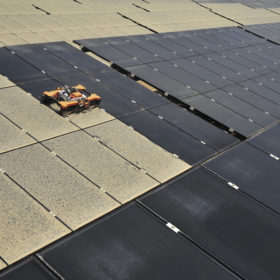
Scientists in the United States and India are investigating the impacts of soiling on PV installations in the Indian state of Gujarat. The group, which found that soiling losses for the state could add up to $12 million per year, is looking for low-cost ways to monitor and reduce the impacts of soiling on modules in the field.
Soiling from dust and particulate matter buildup on a module’s surface is estimated to reduce a PV installation’s output by as much as 40% if left unchecked. And while effective solutions do exist, in the form of anti-soiling coatings for module glass and various module cleaning solutions, the whole PV industry can still benefit from a deeper understanding of the mechanisms at work in soiling.
Scientists from Duke University in the United States, working alongside the Indian Institute of Technology (IIT), recently conducted a field study to bring clarity to some of the less-studied aspects of soiling, including the source and properties of the actual dust, and the influence of weather conditions such as humidity on module soiling.
On a rooftop at IIT’s campus in Gandhinagar, the capital city of Gujarat, the group set up monitoring and sampling equipment for a five-month period from September 2018 to January 2019. Two 50 W multicrystalline modules were set up facing south, with one cleaned nightly as a reference module. The group measured module output, temperature, and short circuit current, as well as weather conditions, at five-minute intervals. They also took samples of the dust that had gathered on the module surface every three weeks.
Their field study showed that particles measuring less than 5 micrometers accounted for as much as 50% of the soiling losses, but less than 10% of the overall particle mass. Heavy rain (more than 8mm per hour) serves to clean the modules, but light rain and high humidity can actually double the soiling rate.
Low-cost monitoring
The group also devised a new method to estimate soiling rates by using a microscope and camera to take daily images of the deposited particles. Images were taken at night, when lighting could be used to illuminate the particles against the dark sky. The group says that this enabled them to estimate soiling rates within 1% accuracy, and could be rolled out as a low-cost solution in the field.
The study concludes that methods for module cleaning should focus on removing particles measuring less than 5 micrometers to be most effective. It also finds that measuring relative humidity could be a better indicator for soiling than airborne particulate matter, and that overall energy yields from solar could greatly benefit from cleaner, clearer air.
Lắp đặt điện mặt trời Khải Minh Tech
https://ift.tt/2X7bF6x
0906633505
info.khaiminhtech@gmail.com
80/39 Trần Quang Diệu, Phường 14, Quận 3
Lắp đặt điện mặt trời Khải Minh Tech
https://ift.tt/2ZH4TRU
Không có nhận xét nào:
Đăng nhận xét